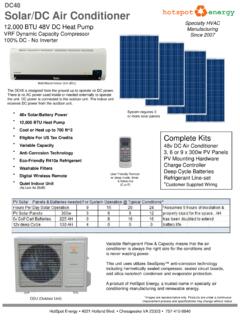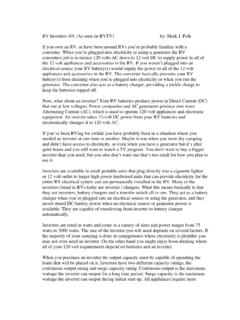Transcription of Why PWM?Why PWM? What is PWM?
1 MORNINGSTAR CORPORATION1 Why PWM?Why PWM?The technology for solar photovoltaic battery charge controllers has advanced dramatically over the past fiveyears. The most exciting new technology, PWM charging, hasbecome very popular. SomeFrequently Asked Questions about PWM battery charging are addressed is PWM?Pulse Width Modulation (PWM) is the mosteffective means to achieve constant voltagebattery charging by switching the solar systemcontroller s power devices. When in PWMregulation, the current from the solar array tapers according to the battery s condition and recharging is there so much excitement about PWM?Charging a battery with a solar system is aunique and difficult challenge.
2 In the old days, simple on-off regulators were used to limitbattery outgassing when a solar panel producedexcess energy. However, as solar systems maturedit became clear how much these simple devicesinterfered with the charging process. The history for on-off regulators has been earlybattery failures, increasing load disconnects, andgrowing user dissatisfaction. PWM has recentlysurfaced as the first significant advance in solarbattery solar chargers use technology similar toother modern high quality battery a battery voltage reaches the regulationsetpoint, the PWM algorithm slowly reduces thecharging current to avoid heating and gassing ofthe battery, yet the charging continues to returnthe maximum amount of energy to the batteryin the shortest time.
3 The result is a highercharging efficiency, rapid recharging, and ahealthy battery at full addition, this new method of solar batterycharging promises some very interesting andunique benefits from the PWM pulsing. Theseinclude:1. Ability to recover lost battery capacity anddesulfate a battery. 2. Dramatically increase the charge acceptance of the battery. CORPORATION23. Maintain high average battery capacities (90%to 95%) compared to on-off regulated state-of-charge levels that are typically 55% to 60%. 4. Equalize drifting battery cells. 5. Reduce battery heating and gassing. 6. Automatically adjust for battery aging. 7. Self-regulate for voltage drops and temperatureeffects in solar benefits are discussed in more detail in thefollowing does this technology help me?
4 The benefits noted above are technology more important question is how the PWMtechnology benefits the solar system user. Jumping from a 1970 s technology into the new millennium offers: Longer battery life: reducing the costs of the solar system reducing battery disposal problems More battery reserve capacity: increasing the reliability of the solar system reducing load disconnects opportunity to reduce battery size to lowerthe system cost Greater use of the solar array energy: get 20% to 30% more energy from yoursolar panels for charging stop wasting the solar energy when thebattery is only 50% charged opportunity to reduce the size of the solararray to save costs Greater user satisfaction: get more power when you need it for lessmoney!
5 !Are all of these benefits tested and proven?A great deal of testing and data supports thebenefits of PWM. More information is attachedthat describes the technology and various studies. Morningstar will continue our ongoing testprograms to refine the PWM charging time, each of these benefits will be improvedand more clearly defined with numbers all PWM chargers the same?Buyer beware! Many solar charge controllers thatsimply switch FETs differently than the on-offalgorithm claim to be a PWM charger. Only a few controllers are actually using a Pulse WidthModulated (PWM) constant voltage chargingalgorithm. The rest are switching FETs withvarious algorithms that are cheaper and was awarded a patent in 1997 for ahighly effective battery charging algorithm basedon true PWM switching and constant voltagecharging.
6 All Morningstar products use thispatented PWM?CONTINUEDADDENDUM TO WHY PWM?MORNINGSTAR to recover lost battery capacityAccording to the Battery Council International,84% of all lead acid-battery failures are due tosulfation. Sulfation is even more of a problem in solar systems, since opportunity charging differs significantly from traditional batterycharging. The extended periods of underchargingcommon to solar systems causes grid corrosion,and the battery s positive plates become coatedwith sulfate s PWM pulse charging can deter theformation of sulfate deposits, help overcome theresistive barrier on the surface of the grids, andpunch through the corrosion at the interface.
7 Inaddition to improving charge acceptance andefficiency, there is strong evidence that thisparticular charging can recover capacity that hasbeen lost in a solar battery over time. Someresearch results are summarized 1994 paper by CSIRO, a leading batteryresearch group in Australia (reference 1), notes that pulsed-current charging (similar toMorningstar controllers) has the ability torecover the capacity of cycled cells. The sulfatecrystallization process is slowed, and the innercorrosion layer becomes thinner and is dividedinto islands. The electrical resistance is reducedand capacity is improved. The paper s conclusionis that pulse charging a cycled battery can evokea recovery in battery capacity.
8 Another paper, a Sandia National Labs study in1996 (reference 2, attached), summarizes testingof a VRLA battery that had permanently lostover 20% of its capacity. Conventional constantvoltage charging could not recover the lostcapacity. Then the battery was charged with aMorningstar SunSaver controller, and much ofthe battery capacity has been recovered. Finally, Morningstar has been testing for capacity recovery. An attached graph (reference3, attached) shows how a battery that was dead recovered much of its lost capacity afterextended charging with a SunLight controller. After the test was set-up, for 30 days the solarlighting system produced virtually no lightingsince the system went directly into LVD eachnight.
9 The battery was very old and about to berecycled. Then, the load began to turn on longereach night as shown on the graph. For the next 3months the battery capacity steadily test and other capacity recovery tests areongoing at battery charge acceptanceCharge acceptance is a term often used todescribe the efficiency of recharging the solar batteries are constantly rechargingwith a limited energy source ( opportunitycharging with available sunlight), a high chargeacceptance is critical for required battery reservecapacity and system PV systems have a history of problems dueto poor battery charge acceptance. For example, a study of four National Forest Service lightingsystems (reference 4) using on-off shuntcontrollers clearly demonstrated the problemscaused by low charge acceptance.
10 The batteriesremained at low charge states and went into LVDevery night, but the battery typically acceptedonly about one-half the available solar energythe next day during charging. One system onlyaccepted 10% of the energy available from thearray between 11:00 AM and 3:00 PM!After extensive study, it was determined that the problem is in control strategy, not in thebattery. Further, the battery was capable ofaccepting that charge, but it wasn t beingcharged. Later a system similar in all respects except using a constant voltage charge controllerwas studied. In this case, the battery is beingmaintained in an excellent state of charge. A later study specific to Morningstar s PWMconstant voltage charging by Sandia (reference 2,attached) found that the SunSaver s increasedcharge acceptance is due to the PWM chargealgorithm.












